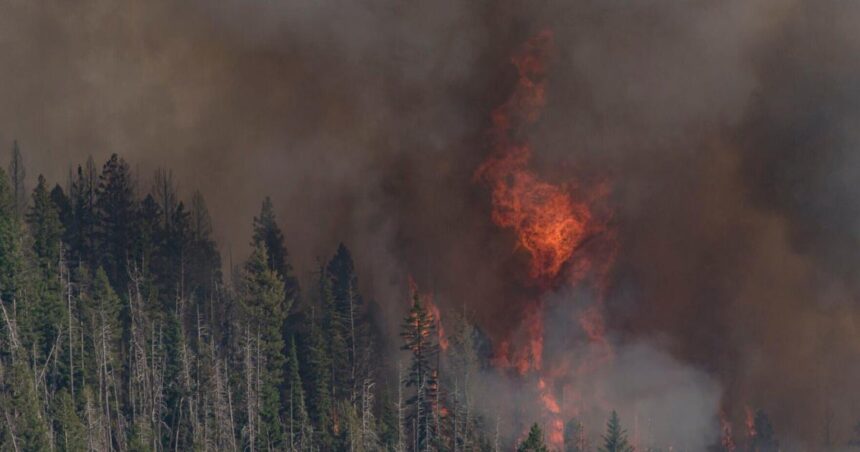Campfires and other activities that could spark wildfires are being banned across parts of western Montana as dry, hot weather creates extreme risk for wildfires.
The Lolo and Bitterroot national forests raised their fire danger to “extreme,” the highest of five levels, earlier this week. Missoula County followed suit Wednesday afternoon.
And the Lolo and Bitterroot forests; Missoula and Ravalli counties; Montana’s Department of Natural Resources and Conservation and Department of Fish, Wildlife & Parks, and the Confederated Salish and Kootenai Tribes all enacted Stage-2 fire restrictions, which outright prohibit campfires in any circumstance and a host of other activities that can cause wildfires.
Flames shoot up from the Miller Peak fire as it burns north of Holloman Saddle in the northern Sapphire Mountains on Monday, July 15, 2024. The fire ignited Sunday and approached 2,000 acres burned on Wednesday.
The national forest restrictions cover all lands within the Bitterroot National Forest. The CSKT restrictions cover lands within the Flathead Reservation. Missoula County’s restriction covers all private property in the county, except inside Missoula city limits. (Campfires are always illegal in Missoula.) The Lolo and Bitterroot forests and Missoula County restrictions take effect Friday. The CSKT restrictions take effecting beginning Saturday.
People are also reading…
The DNRC and FWP restrictions cover state trust lands, private lands classified as forested lands, wildlife management areas, fishing access sites and state parks in Missoula, Ravalli and Sanders counties. The state restrictions take effect Friday.
Adriane Beck, the county’s disaster and emergency services coordinator and director of the Office of Emergency Management, told county commissioners Thursday that the restrictions were “a unique extra tool that we deploy when necessary … to reduce as many human caused fires as we can.”
“This really is a way to convey the risk to the public and hopefully change some behavior,” she said.
Stage-2 fire restrictions are mostly the same between jurisdictions and land-management agencies, with some slight variations in wording. But the activities they prohibit are often identical.
The restriction prohibits — at all times and with no exceptions — “building, maintaining, attending, or using a fire or campfire.”
Smoking is prohibited at all times, unless done inside an enclosed vehicle or in a 3-foot diameter space that’s barren or has been cleared of all flammable materials.
Operating motor vehicles off designated roads and trails is prohibited at all times, except for certain government, infrastructure or utility company business. Fire extinguishers and wildland fire tools are required to conduct those excepted activities.
Stoves or grills with open flames are also prohibited, with some exceptions. Devices fueled solely by liquid propane or liquid propane gas — and that can be switched off — are allowed only in a 3-foot diameter of a barren or cleared area that has also been cleared overhead of flammable materials.
Other activities are prohibited from 1 p.m. to 1 a.m., the hottest and often hours time of the day. These include: Operating devices with internal-combustion engines; welding or operating a torch; or using explosives.
There are some specific exceptions. Generators are allowed if they are equipped with an approved spark-arrestor device on the exhaust system and are inside an enclosed vehicle or on a 3-foot diameter of barren or cleared space. Welding and torches are allowed inside enclosed buildings. And agricultural activities, other than timber harvest, are allowed in non-forested areas.
New fires start as Miller Peak barely grows
Multiple new fires were discovered across western Montana Wednesday afternoon and overnight into Thursday.
Crews were dispatched to the Deer Creek fire along Deer Creek Road at Milltown State Park at 2:51 p.m. Wednesday. The fire burned 14 acres along the south side of the BNSF Railway mainline that runs through the area, immediately east of Deer Creek Road and around the park’s parking lot.
Crews from Missoula Rural Fire District, Missoula Fire Department, the U.S. Forest Service and DNRC responded and controlled the fire that afternoon.
Later, also along the south edge of the BNSF mainline but farther northwest in downtown Thompson Falls, residents there reported flames coming from the second locomotive in a westbound train that passed through town. Residents reported “multiple” fire starts along the tracks in the area.
The locomotive ignited at least one fire in town: Crews were dispatched to the quarter-acre West Ramp fire at 8:22 p.m. and brought it under control. That fire, too, was immediately on the south side of the tracks.
Separately, a small fire was discovered around 3:23 a.m. Thursday, high on a mountainside north of Interstate 90 near St. Regis. The Beacon Hill fire was burning about 2.5 miles east-southeast of St. Regis and just over a mile northeast of the interstate. The fire was contained at 1.5 acres. The Lolo National Forest didn’t state a cause of the fire Thursday. Lightning passed through the area overnight.
The Miller Peak fire about 10 miles southeast of downtown Missoula and barely 5 miles west of Clinton hardly grew on Wednesday.
The fire was 2,035 acres as of Thursday morning, according to a daily update from fire managers — an increase of only 63 acres in 24 hours. But, fire managers cautioned, a weather “disturbance” Thursday could bring gusty winds that exacerbate fire behavior. The fire remained 0% contained.
Crews continued to work Thursday on holding the northern edge of the fire to the Plant Creek drainage, where it ignited Sunday afternoon, and stopping its front along Moccasin Ridge west of Clinton. As of Thursday morning, 352 personnel were working the fire across 12 engine crews, 20 hand crews, three helicopters, six pieces of heavy equipment like bulldozers and overhead personnel.
An evacuation warning remained in effect from about Park Creek to Holloman Creek on Miller Creek Road — an area partially within the Lolo National Forest and home to a handful of farms, ranches and cabins. Miller Creek Road is closed at the beginning of Lost Mine Loop. Fire personnel and residents of homes past the closure are allowed through.
The Forest Service implemented an area and road closure around the fire, effective beginning Tuesday. The closure stretches from Eightmile Saddle, just north of Gilbert Creek, on the south to the upper Deer Creek drainage south of Pattee Canyon Recreation Area on the north. The closure does not include the popular recreation area, but it does include the upper Deer Creek Road and Skyline trailhead area. The closure extends to the Lolo National Forest boundaries on the east and west, which on the east is barely outside Clinton.
Emergency proclamation
Before unanimously approving Stage-2 fire restrictions, the Missoula County Commission also unanimously approved a disaster proclamation for the 2024 wildfire season.
The proclamation wasn’t specific to any one fire, but rather recognized that “wildland fire under the current conditions has the potential to over-extend or exhaust local fire suppression resources, thereby threatening lives and property.”
The proclamation, Beck explained, begins to enact the county’s emergency operation plan, which authorizes certain first responders and incident managers to do things like conduct evacuations or block people from entering an area. The proclamation also facilitates the tracking and recording of costs associated with fire impacts so the county can seek state or federal reimbursement if it meets certain thresholds.
Joshua Murdock covers the outdoors and natural resources for the Missoulian. He previously served as editor-in-chief of The Boulder Monitor in Jefferson County, Montana, and has worked as a newspaper reporter and photographer in rural towns in Idaho and Utah.





